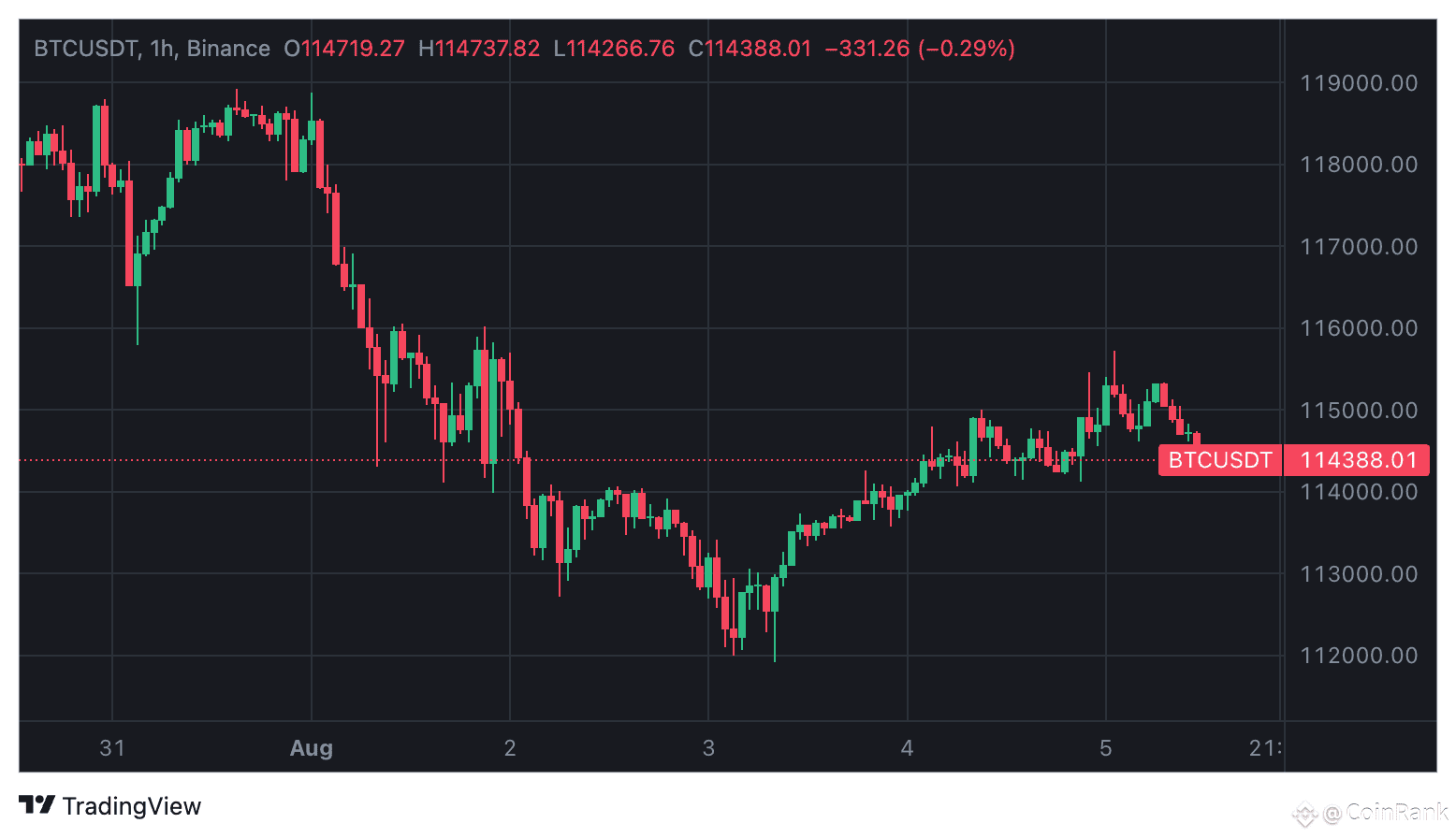Crypto markets rebounded on August 4 after sharp losses, driven by rate cut hopes and a correction of last week’s overly negative sentiment.
Despite record ETF outflows, long-term institutional inflows remain strong, showing continued confidence in Bitcoin, Ethereum, and the broader crypto ecosystem.
Weak U.S. job data and political turmoil sparked short-term fear, but also fueled expectations for monetary easing, supporting risk assets like cryptocurrencies.

After a week of high volatility, the global cryptocurrency market showed strong recovery on Monday, August 4, 2025. Major digital assets like Bitcoin (BTC), Ethereum (ETH), Ripple (XRP), and Solana (SOL) saw significant price rebounds. The total market cap rose to $3.85 trillion. This recovery is not only a response to last week’s ETF outflows and weak U.S. employment data but also reflects investor sentiment under political and economic uncertainty.
STRONG REBOUND IN THE CRYPTO MARKET
According to CoinGecko, as of August 4, the total market cap of cryptocurrencies reached $3.85 trillion, with a 24-hour increase of 2.3%. Trading volume reached $108 billion.

Meanwhile, market volatility triggered large-scale liquidations. According to CoinGlass, more than $230 million in crypto positions were liquidated in the past 24 hours. Short positions made up $179 million of that. Ethereum had the highest liquidation amount at about $80 million, ahead of Bitcoin’s $44 million. This shows the market faced intense short-term battles between bulls and bears.
Analysts see this price rebound as a correction after last week’s overly negative sentiment. On Friday, August 1, the crypto market dropped sharply due to weaker-than-expected U.S. employment data and political unrest. However, investors seemed to quickly digest the negative news and regain confidence in digital assets. What caused the rebound? The answer may lie in the mix of ETF flows and macroeconomic signals.
CONFIDENCE RETURNS AFTER CRYPTO ETF OUTFLOWS
RECORD-BREAKING OUTFLOWS
Crypto ETFs connect traditional finance with digital assets. Their fund flows reflect market sentiment. On August 1, data showed that spot Bitcoin ETFs had a net outflow of $812 million in one day — the second-largest single-day outflow since ETFs launched in January 2024. Ethereum ETFs also saw $152 million in net outflows, ending 20 days of positive inflows in July.
CoinShares reported a total net outflow of $223 million from digital asset investment products last week. This reversed the $883 million net inflow from earlier in the week. Bitcoin ETFs led with $404 million in outflows, while Ethereum ETFs still had $133 million in inflows — continuing a 15-week streak of positive inflows. Despite short-term outflows, year-to-date inflows remain strong: Bitcoin ETFs have brought in $20 billion, and Ethereum ETFs have steady support.
REASONS BEHIND THE OUTFLOWS
CoinShares said the main reasons for ETF outflows were strong Fed signals and worries about the economic outlook. On August 1, weak U.S. job data increased market fear, causing more than $1 billion in outflows in one day. But the report also noted that $12.2 billion in net inflows came in over the past 30 days — 50% of this year’s total — suggesting short-term profit-taking may explain the drop rather than a long-term trend reversal.
Analysts believe the ETF outflows show cautious investor behavior during uncertain times. But the long-term trend of inflows proves that institutions still have confidence in crypto. Ethereum ETFs, in particular, continue to attract interest, showing belief in its ecosystem’s future, including DeFi and smart contracts.
U.S. EMPLOYMENT DATA: ECONOMIC SIGNALS AND MARKET REACTIONS
A DISAPPOINTING JOBS REPORT
The July U.S. jobs report, released on August 1, triggered market volatility. The report showed only 73,000 new jobs in July — far below expectations. Previous months’ numbers were also revised down by 258,000. The unemployment rate rose from 4.1% in June to 4.2%. This raised concerns about a weakening labor market. These results were below economists’ forecasts and conflict with the Fed’s inflation control goals.
The weak data increased market expectations for a rate cut in September. According to the CME FedWatch tool, bets on a Fed rate cut rose sharply after the report. This aligns with President Trump’s repeated calls for easier monetary policy. But instead of optimism, political uncertainty added more pressure to the market.
TRUMP’S POLITICAL ACTIONS AND MARKET MOOD
On the same day the jobs data came out, Trump suddenly fired Erika McEntarfer, head of the Bureau of Labor Statistics (BLS). He posted on Truth Social, saying the job report was “manipulated” and that monthly revisions were “fake,” designed to hide the economic truth and hurt the Republican image. His statements made investors question the credibility of the data, increasing market anxiety.
Trump wrote: “These massive adjustments are designed to hide and smooth out fake political numbers — numbers made up to make the Republican victory look less impressive!!!” Although there is no solid proof for these claims, they added a political layer to market movements.
On August 4, National Economic Council Director Kevin Hassett said the White House plans to appoint “high-quality talent” to the BLS, bringing a “new beginning and perspective.” This may be an effort to ease concerns about data transparency. Still, political interference continues to cast a shadow on the market in the short term.
DEEPER REASONS BEHIND THE MARKET REBOUND
SHORT-TERM CORRECTION AND LONG-TERM CONFIDENCE
The crypto market rebound on Monday shows that investors corrected last week’s overly negative mood. Although job data and political turmoil caused short-term selling, the market quickly recovered. Several factors may have helped:
Rate Cut Expectations Rise: Weak job data made a Fed rate cut in September more likely. Easy monetary policy usually supports risk assets like crypto.
ETF Outflows Slowing Down: Despite large outflows last week, long-term trends show that institutional investors have not fully exited. The market may see outflows as profit-taking, not panic.
Technical Rebound: After weekend lows (such as BTC at $112,300), technical buying and short covering may have pushed prices up.
POLITICS AND ECONOMICS INTERTWINED
Trump’s political moves caused short-term market stress. However, his support for rate cuts may indirectly help the crypto market. Rate cuts usually weaken the dollar and raise risk asset prices. Crypto, being volatile, often benefits from such expectations. But political actions like interfering with data agencies can cause long-term uncertainty. Investors should closely watch future policy changes.
CONCLUSION
The crypto market rebound on August 4, 2025, was both a technical correction and a response to weak job data and political instability. Although ETF outflows and political uncertainty caused short-term fear, long-term fund inflows and rate cut hopes offered support. Investors should watch the Fed’s policy and political developments closely while carefully weighing the risks and opportunities in a volatile market. In a time of mixed economic and political signals, crypto continues to show resilience and potential.
〈Cryptocurrency Market Rebounds After Negative Data〉這篇文章最早發佈於《CoinRank》。



